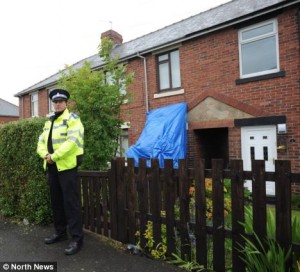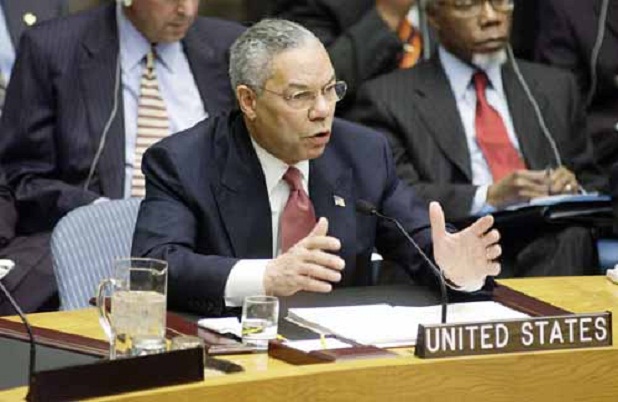Politics | ‘Ricin!’: the plot that never was
Ideas, New in Ceasefire - Posted on Wednesday, October 13, 2010 5:36 - 11 Comments
Colin Powell referred to the ‘Ricin Plot’ during his infamous presentation at the UN, on February 05, 2003
By Lawrence Archer
I knew what the buff envelope was as soon as I spotted it on the doormat; another jury summons. My heart sank. I’d served on a jury in an assault case only two years previously and it had been a brutal experience. The CCTV evidence of a young man being struck on the back of the head with an axe still stayed with me. But this new summons was to the Old Bailey: now that could be interesting. As it turned out, it was life changing.
I was to become the jury foreman in the first terrorism trial in Britain since 9/11. The case became known as the Ricin Trial, since the prosecution alleged that a group of Algerian men were conspiring to manufacture explosives and toxins, including the deadly poison ricin, for terrorist purposes.
The case came to court in September 2004. Five men stood in the dock, while a further four were scheduled to be tried in a follow-on trial, the Court Service considering, probably correctly, that prosecuting nine defendants at once would have both crammed the courtroom and confused any jury. The defendants were a disparate bunch, mostly associated with each other through the Finsbury Park mosque.
Although it has since become inextricably linked with terrorism by the presence of the notorious preacher Abu Hamza, the mosque had previously served a different and rather more peaceful purpose, providing a focal point for the large Algerian community who lived in the neighbourhood. Men would meet, socialise, eat, swap information on jobs and lodgings and even sleep at the mosque, although the latter was an informal arrangement and frowned upon by the mosque trustees.
The five Algerian defendants, Kamel Bourgass, Mouloud Sihali, David Khalef, Mustapha Taleb and Sidali Feddag, were all charged on two counts: Conspiracy to murder and “Conspiracy to cause a public nuisance”, a 19th century piece of legislation that had been resurrected by the CPS for the trial.
Information had come into the British authorities in early January 2003 that a group of Algerian terrorists was going to strike the UK imminently. The news understandably caused huge consternation at Scotland Yard and within a matter of days Anti Terror Branch officers carried out a raid on a property in Wood Green, North London. The shabby one bed flat, provided for the 17 year old Sidali Feddag whilst his asylum claim was being processed, was searched thoroughly for poisons and explosives.
Feddag had met Kamel Bourgass at the Finsbury Park mosque some months earlier and had offered him accommodation in the flat when he realised Bourgass was homeless. However, Feddag had asked Bourgass to leave a matter of weeks before the raid when his brother needed somewhere to stay. Bourgass had duly obliged, but crucially left many of his possessions behind. Among these were some suspicious items: rubber gloves, thermometers, bottles of chemicals, a small quantity of castor oil seeds (the principle ingredient for making ricin), a large sum of cash and most damning of all, a hand written set of recipes for manufacturing a variety of toxins and explosives, contained in a locked sports bag. The recipes were later identified as being written by Bourgass and his fingerprints covered the other suspicious finds.
Scientists from the government research laboratories at Porton Down carried out generic testing for the presence of proteins on some of the items found at the scene. One item, a mortar and pestle, showed a very weak positive reaction to this onsite testing, but later highly specific tests for ricin, carried out at the laboratory, proved the initial analysis to be misleading. According to the chief scientist, in his evidence to the Old Bailey, he had declared the tests negative. As far as he was concerned, there was no ricin at Wood Green.
A series of arrests followed, although the main suspect, Kamel Bourgass, was missing. Mustapha Taleb was picked up almost immediately, after his fingerprint was discovered on a photocopy of the poison recipes. David Khalef had been arrested some months earlier in Norfolk, found in possession of a copy of the recipes. Mouloud Sihali had been picked up at the same time as Khalef. He had connections with one of the chief suspects in the alleged conspiracy, having let him stay in his flat for a number of weeks.
Despite Porton Down knowing within 48 hours of the raid that there were no toxins found at the scene, the police had somehow been notified of the exact opposite. The ensuing media reports were unequivocal; there was a “factory of death” in Wood Green and a quantity of ricin had been discovered. Government spokesmen confirmed the find, announcing in a public statement that “a small amount of the material recovered from the Wood Green premises has tested positive for the presence of ricin….. The Department (of Health) is now alerting the health service, including primary care, about these developments.” Prime Minister Tony Blair weighed in later the same day, announcing to a meeting of British ambassadors in London “The arrests which were made show this danger is present and real and with us now. Its potential is huge. ”
 The startling headlines almost certainly scared Kamel Bourgass into fleeing London. Within a few days he was holed up in a Manchester flat belonging to a distant acquaintance. When police arrived at the flat several days later, entirely coincidentally and in order to detain another man unconnected with the ricin plot, Bourgass was recognised and promptly arrested.
The startling headlines almost certainly scared Kamel Bourgass into fleeing London. Within a few days he was holed up in a Manchester flat belonging to a distant acquaintance. When police arrived at the flat several days later, entirely coincidentally and in order to detain another man unconnected with the ricin plot, Bourgass was recognised and promptly arrested.
What happened next was withheld from the ricin trial jury, to avoid prejudicing the evidence. Bourgass broke free from the officers guarding him, snatched a knife from the kitchen and attempted to escape.
In the ensuing chaos he violently stabbed police officer Stephen Oake to death and badly wounded several others before he was finally restrained.
Shockingly, the myth of the ricin find was soon to have an even greater effect. Despite the fact that Porton Down knew there was no ricin at Wood Green in early January 2003, Colin Powell, then US Secretary of State, mentioned its definite discovery several weeks later on February 5th, as part of his presentation to the United Nations Security Council. Arguing the case for the invasion of Iraq, Powell cited the Wood Green “find” as a cause for grave concern and linked it to an “Iraq-linked terrorist network”. British and American forces invaded the country within a matter of weeks.
At the end of the ricin trial, which had lasted seven months, cost an estimated £20 million and caused the jury to deliberate for 17 days, Bourgass was convicted on the lesser, although still serious, charge of Conspiracy to cause a public nuisance. The jury were unable to reach a decision on the Conspiracy to murder charge and were eventually discharged. Bourgass had in fact already been convicted of murder and malicious wounding in a previous Old Bailey trial, kept deliberately secret to avoid any press revelations, and was serving a lengthy jail sentence. The other four defendants, Sihali, Taleb, Khalef and Feddag were found not guilty on all charges.
The second, follow on, trial collapsed, as the CPS decided there was little realistic hope of any convictions, as much of the evidence alleged against them was linked to the original defendants. While several of the defendants had entered the UK illegally, they had all served enough time in custody to be released after a few days and were let out on normal immigration bail conditions.
A reporting embargo in place since early 2003 had meant that the press had been unable to publicise the case until the verdicts came in. Now, after the jury had announced its decisions, the media had a field day, declaring Bourgass to be “The Toxic Terrorist” and claiming that he had Al Qaeda connections. The original intelligence given to the British authorities was revealed to have come from another Algerian man, Mohammed Meguerba, who had been interrogated by the DRS, Algeria’s notoriously brutal secret police who had a fearsome reputation for using torture during their questioning.
While Bourgass was making all the headlines, the other defendants received scant media coverage. The general opinion seemed to be that they had “got away with it”, despite the jury’s lengthy deliberations and Not Guilty verdicts. Politicians and the police were equally disappointed in the jury decisions: there were even mutterings in some quarters that the jury had “gone rogue”. Home Secretary Charles Clarke announced that he would be keeping “a close eye” on the cleared men, while Met Police Commissioner Sir Ian Blair told David Frost on his TV show that the law might have to be amended following the verdicts. “I think we’ll just have to look again, to see if there’s some other legislation around ‘acts preparatory to terrorism’ or something of that nature, that’s what we’ll have to do.”
The jury went back to their day jobs, but the story wasn’t over for the cleared defendants. Within weeks, the government announced its intention to deport them to their native country, despite the fact that Algeria had an appalling record on human rights and the defendants had been tarred with the brush of “terrorist”. When it seemed that there might be legal difficulties with the deportation process, the British government attempted to negotiate Memoranda of Understanding with the more contentious countries, including Libya and Algeria. (Libya signed up. Algeria refused, on the grounds that it didn’t go in for mistreatment of detainees, so there really was no need). A lengthy legal battle ensued to derail the deportations, but far worse was to come for two of the men.
 Following the 7th July and failed 21st July 2005 bombings on London Transport targets, and the shooting of Jean Charles de Menezes, the British public were understandably jittery, and fear of terrorism was running at fever pitch. New anti terror legislation was hurriedly put together.
Following the 7th July and failed 21st July 2005 bombings on London Transport targets, and the shooting of Jean Charles de Menezes, the British public were understandably jittery, and fear of terrorism was running at fever pitch. New anti terror legislation was hurriedly put together.
In the early morning of 15th September 2005, coincidentally the same day as Home Secretary Charles Clarke announced plans for 90 day detention of terror suspects, police stormed the properties of Mustapha Taleb and Mouloud Sihali.
Both were detained as “threats to national security”, although neither has ever been charged with any offence or even interviewed by the police. After several months in jail they were both released, subject to strict immigration bail conditions (Control Orders in all but name). Terms of their release included wearing an electronic tag, being curfewed for up to 22 hours a day, limiting their movements to a small geographical area and having their premises searched regularly. Potential visitors had to be vetted and approved by the Home Office.
Sihali eventually had his case heard by the Special Immigration Appeals Commission (SIAC) which rules on foreign deportation matters. In May 2007, SIAC decided that Sihali posed no danger to the British public and lifted his bail conditions, although he remains threatened with deportation to this day and is fighting it through the appeal courts. Mustapha Taleb has not been that fortunate. He was put back in jail for two years, where he was adjudged to be a severe suicide risk by the prison psychiatrist. He currently lives in a provincial town, subjected once again to strict bail conditions and cooped up in a tiny house for 20 hours a day, kept sane by antidepressant drugs. The British government would like to deport him too, despite the fact that he was granted asylum here in 2000, based on evidence that he had been tortured in Algeria.
David Khalef has been granted leave to remain in the UK and now lives quietly in London. Sidali Feddag is the only one of the cleared defendants with any real sense of achievement after the ricin trial. Impressed by the British jury system, he has gone on to study for a degree in law.
As for me, I was non political before the case. The ricin trial has changed all that.
Lawrence Archer is a writer and engineer. This is his first book.
Fiona Bawdon, who co-wrote the book, is a respected freelance journalist who writes on legal matters.
 “Ricin! The inside story of the terror plot that never was” is released by Pluto Press on 11th October 2010.
“Ricin! The inside story of the terror plot that never was” is released by Pluto Press on 11th October 2010.
Lawrence Archer, Fiona Bawdon
224pp, Paperback
Available from Pluto at £13, rrp £14.99
11 Comments
Ceasefire Magazine – Politics: Ricin! The plot that never was | algertoday
adam
What an incredible story, one that needs to be known and understood far better than the mainstream press would approve
Who is going to bring Colin Powell and Tony Blair to account for this? Both knew before Powell made his address that there was no ricin and there was no plot.
Who is going to pay for those innocents who were held in belmarsh for three years on remand for crime that never existed?
And why are these Algerian men still suffering on control orders, constant harrassment and persecution?
Lawrence – I was intending to write a piece myself on the non-existant “Ricin Plot” for my column, but looks like you’ve beat me to it – and thankfully too. I think the experience you’ve encountered and the subsequent book you’ve written (which i’ve almost completed) is fantastic. Keep up the good work.
In solidarity,
Rizwaan
Tom
So even if there was no full-blown “ricin plot”, was it determined why exactly Feddag was found in possession of handwritten recipes for toxins and explosives, and the materials to make them?
There’s a fascination with ricin in both the media and the security services. It isn’t helped by people who claim that it is a potential WMD or who talk about it being capable of being sprayed in the tube network.
I really don’t know why it persists. Ricin is not a mass weapon and it isn’t even that good as an assassination tool.
What’s hard to know is whether the authorities understand ricin but find it useful to perpetuate the lies or whether they don’t know they are lying.
A civilian worker at the American Embassy in London told me they’d had briefings about potential terrorist acts aimed at the embassy and ricin was included. What she said they’d been told was complete bunkum.
Dr GM Draper
Sidali Feddag was not, as ‘Tom’ suggests, found in possession of recipes for toxins and explosives nor of the materials to make them. As Lawrence Archer points out, he and the others were found Not Guilty by the jury after a lengthy trial and close consideration of the evidence.
Maria
Great article. Unbelievable stuff–yet also, at the same time, entirely believable and unsurprising. Good on Lawrence Archer for writing about it and taking such an interest in the lives of the defendants.
Fixed Schlock From Wood Green… « Back Towards The Locus
[…] Lawrence Archer and Fiona Bawden write, in a precis of their new book Ricin! The Inside Story of the Terror Plot That Never Was, none of […]
[…] I’m cross-posting an article written by Lawrence Archer when his book was published last autumn, which provides the necessary context for concluding that, […]
“Skepticism” As A Plaster For The Powerful… « Back Towards The Locus
[…] by orthodox narratives. We don’t know who carried out the Pan Am attack. Numerous mysteries surround the Iraq invasion. Numerous mysteries surround the whole damn “War on Terror”: […]



[…] the deportations, but far worse was to come for two of the men. … See the original post: Ceasefire Magazine – Politics: Ricin! The plot that never was Share and […]